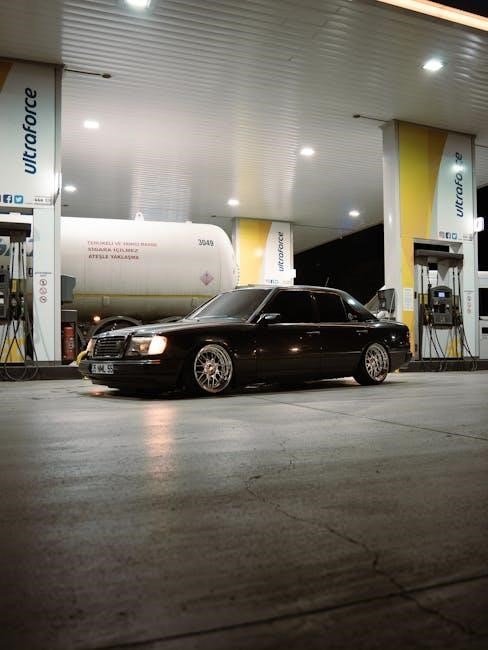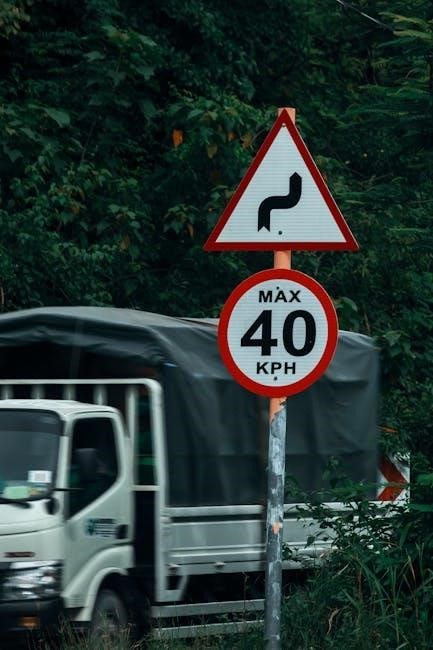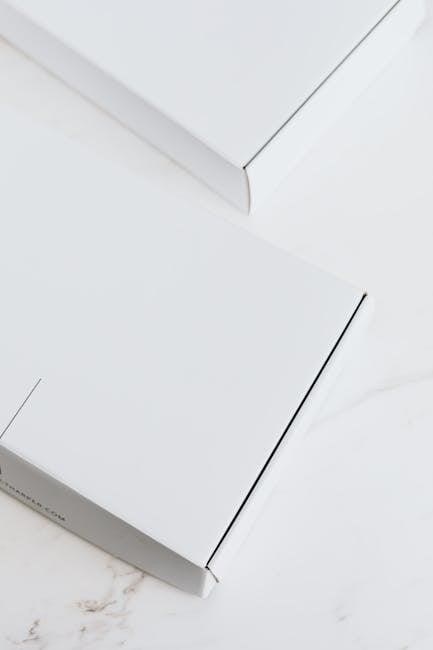Lenze drives are advanced motor control systems widely used in industrial automation, offering precise control and high efficiency. Fault codes in Lenze drives indicate malfunctions, aiding in quick diagnosis and resolution. Understanding these codes is essential for maintaining productivity and ensuring system reliability. This article provides a comprehensive guide to Lenze drive fault codes, their classification, and troubleshooting strategies.
Overview of Lenze Drives and Fault Codes
Lenze drives are high-performance motor control systems used in industrial automation, ensuring precise control and efficiency. They utilize fault codes to indicate malfunctions, aiding in swift diagnosis and resolution. These codes, such as EF (External Fault) and IL (Internal Logic), are categorized to pinpoint issues like overloads, communication faults, or internal errors. Detailed in manuals like the Lenze 8400 High Line guide, these codes help users identify and address problems effectively, minimizing downtime and optimizing system performance.
Importance of Understanding Fault Codes
Understanding Lenze drive fault codes is crucial for efficient troubleshooting, minimizing downtime, and ensuring system reliability. These codes provide insights into specific issues, enabling quick diagnosis and targeted solutions. By interpreting fault codes, users can address problems like overloads or communication errors before they escalate, ensuring operational safety and compliance. Regular analysis of fault codes also supports preventive maintenance, helping to optimize performance and extend the lifespan of the drive system.
Purpose of the Article
This article aims to provide a detailed guide to understanding and resolving Lenze drive fault codes. It covers the classification of fault codes, methods for interpretation, and troubleshooting common issues. The purpose is to empower users with practical knowledge to diagnose and fix problems efficiently. By exploring fault code definitions, communication protocols, and preventive maintenance strategies, this guide helps engineers and technicians optimize drive performance, reduce downtime, and ensure smooth industrial operations. The content is designed to be both informative and actionable for professionals working with Lenze drives.

What Are Lenze Drive Fault Codes?
Lenze drive fault codes are numerical or alphanumerical indicators signaling specific malfunctions within the drive system, helping users identify and address issues efficiently.
Definition and Types of Fault Codes
Lenze drive fault codes are predefined indicators used to identify specific issues within the drive system. These codes are displayed on the drive’s interface or via communication protocols. They are categorized into types such as External Fault (EF) codes, triggered by external factors like sensor issues, and Internal Logic (IL) codes, related to internal drive malfunctions. Additionally, common fault codes address issues like overloads, overheating, and communication errors, providing clear guidance for troubleshooting and resolving drive-related problems efficiently.
Where to Find Fault Codes
Lenze drive fault codes can be accessed through the drive’s interface, communication protocols, or system manuals. The drive’s display provides real-time fault information, while communication tools like DeviceNet allow remote monitoring. Detailed fault code descriptions and solutions are available in the Lenze system manual or supplementary documentation. Additionally, internal fault codes can be retrieved using specific parameters, such as the 800 index, ensuring comprehensive access to diagnostic data for efficient troubleshooting and resolution of drive-related issues.

Classification of Lenze Drive Fault Codes
Lenze drive fault codes are categorized into External Fault (EF), Internal Logic (IL), and other common codes, each indicating specific issues like overcurrent, overheating, or communication errors.
External Fault (EF) Codes
External Fault (EF) codes in Lenze drives are triggered by issues outside the drive itself, such as emergency stop activation, sensor malfunctions, or incorrect parameter settings. These codes indicate problems with external components or configurations that affect the drive’s operation. Examples include faults caused by overcurrent, undervoltage, or communication errors from connected devices. Resolving EF codes often requires addressing the external issue, such as repairing sensors or adjusting settings. Referencing the Lenze user manual is essential for specific code interpretations and solutions to ensure proper troubleshooting and system restoration.
Internal Logic (IL) Codes
Internal Logic (IL) codes in Lenze drives are not directly visible to the user but are stored in the drive’s internal memory. These codes indicate issues within the drive’s logic or firmware, such as parameter conflicts or software errors. Accessing IL codes often requires specialized tools or parameters, like the 800 index; Resolving IL codes may involve updating the drive’s firmware to the latest version or performing a factory reset. Consulting Lenze technical support is recommended for persistent issues to ensure proper resolution and system stability.

Other Common Fault Codes
Other common fault codes in Lenze drives include overload, overheating, and communication errors. Overload faults occur when the motor current exceeds specified limits, often due to excessive mechanical load. Overheating faults indicate that the drive’s temperature has surpassed safe operating levels, requiring immediate attention to prevent damage. Communication faults, such as data corruption or wiring issues, disrupt data transmission between the drive and control systems. Addressing these faults promptly ensures optimal performance and prevents further complications. Regular monitoring and maintenance are crucial for early detection and resolution.

How to Interpret Lenze Drive Fault Codes
Interpreting Lenze drive fault codes involves reading them from the drive interface or using communication protocols to identify issues like overloads, overheating, or communication faults, enabling quick resolution.
Reading Codes from the Drive Interface
Lenze drive fault codes can be directly read from the drive’s interface, providing immediate insights into system issues. The interface displays codes such as “OVERLOAD” or “IL01,” indicating specific malfunctions. Users can access the fault history to view recent issues, including the fault message and the drive’s status at the time of occurrence; For example, an “OVERLOAD” fault may appear during acceleration. This direct access allows for quick identification and resolution of problems, ensuring minimal downtime and efficient troubleshooting.
Using Communication Protocols

Communication protocols like DeviceNet, EtherCAT, and others enable remote access to Lenze drive fault codes. These protocols allow users to retrieve fault messages and drive statuses via connected systems. For example, DeviceNet can display fault codes such as “OVERLOAD” or “IL01” remotely. This method is ideal for integrated systems, enabling faster troubleshooting without physical access to the drive. Always refer to the user manual for specific protocol instructions, as procedures may vary. This approach enhances efficiency in diagnosing and resolving drive issues.

Troubleshooting Common Lenze Drive Fault Codes

Troubleshooting Lenze drive fault codes involves identifying root causes, such as overloads or communication issues. Use diagnostic tools and fault history to resolve errors efficiently. Always refer to the user manual for specific solutions and update firmware if necessary. Regular maintenance and proper configuration can prevent recurring faults, ensuring optimal drive performance.
Overload and Overheating Issues
Overload and overheating are common issues in Lenze drives, often indicated by specific fault codes. These problems can arise from excessive motor load, insufficient cooling, or incorrect parameter settings. To resolve overload issues, check the motor load and ensure it matches the drive’s capacity. For overheating, verify proper cooling system operation and ambient temperature conditions. If issues persist, consult the user manual or contact Lenze technical support for further assistance. Regular maintenance and monitoring can help prevent these faults.
Communication Faults
Communication faults in Lenze drives occur when data transmission between the drive and control systems is disrupted. Common causes include incorrect parameter settings, wiring issues, or compatibility problems with communication protocols. To resolve these faults, ensure all connections are secure, verify parameter configurations, and update the drive’s firmware if necessary. Using tools like Lenze’s communication software can help diagnose and repair issues. Regular checks of communication cables and settings can prevent such faults from recurring and ensure smooth system operation.

Preventive Maintenance and Best Practices
Regular maintenance checks, including inspecting connections and updating firmware, help prevent faults. Monitoring drive temperatures and ensuring proper cooling can minimize risks and optimize performance.
Regular Maintenance Checks
Regular maintenance is crucial for preventing faults in Lenze drives. This includes checking power supply connections, verifying I/O links, and ensuring proper cooling. Additionally, periodic inspection of motor and drive parameters can help identify potential issues early. Updating firmware and software ensures compatibility and fixes known bugs. Monitoring drive temperatures and vibration levels can prevent overheating and mechanical stress. Performing these checks systematically reduces downtime and prolongs the lifespan of the drive. Always refer to the manufacturer’s guidelines for specific maintenance intervals and procedures.
Updating Firmware and Software
Regularly updating firmware and software is essential for optimal Lenze drive performance. Updates often include bug fixes, enhanced security, and improved functionality. Outdated firmware can lead to compatibility issues or unexpected errors. Always check the Lenze website for the latest versions and follow the installation guidelines carefully. Ensure the drive is powered and connected during updates to avoid interruptions. Keeping the system up-to-date helps prevent faults and ensures compliance with the latest industry standards, minimizing downtime and enhancing overall reliability.
Mastering Lenze drive fault codes is key to efficient troubleshooting and maintenance. Regular updates, preventive checks, and understanding fault classifications ensure optimal performance and minimize downtime.



